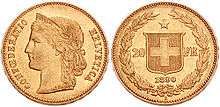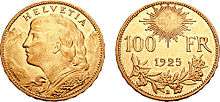Vreneli

Vreneli is the informal name for a range of legal tender gold coins produced in Switzerland. The formal name is: Tête d'Helvetia (French), Helvetiakopf (German) or Helvetia Head (English). The coins were issued between 1897 and 1936, in 1947 and in 1949. All coins issued after 1936 are restrikes (legal tender ceased September 29, 1936.[1]
Description
These coins had face values of 10, 20 and 100 Swiss francs and were minted in a millesimal fineness of 900. The coins are sometimes colloquially called, “Swiss Miss,” from the obvious obverse motif. The 20 franc coin's reverse shows the Swiss shield, featuring the Swiss Cross, and a wreath of oak along with the denomination. The coins were minted at the Swiss Mint at Bern (although the die engraving was done at the Paris mint) and the coins are mint marked with a "B" (without a period). The 20 franc coins are 21 mm in diameter (about the size of a U.S. five cent piece), 1.25 mm in thickness, weigh 6.45 grams (gross weight) and; at 90% pure, contain .1866 ounces or 5.805 grams of pure gold. The 10 franc coin weighs 3,23g and at 90% purity contains 2.9 grams of pure gold.
| Letter | City | Letter | City | Letter | City |
|---|---|---|---|---|---|
| B | Bern | B. | Brussels | BB | Strasbourg |
| AB | Strasbourg | A | Paris | L | lingot/bullion re-strikes |
Years of issue
The coins were issued between 1897 and 1936, in 1947 and in 1949.
Key mintage figures
Around 61 million coins were minted, although only 5,000 of the 100 franc pieces were produced and only in the year 1925. The 20 Franc coin is the most common, and it is popular as a bullion coin. However, the coins also hold a place in numismatic circles.
1926 - 20 francs
Among the 20 franc pieces, the 1926 coin with its mintage of only 50,000 pieces is the ostensible key to that series. However, the 1926 is relatively fairly common and the real keys to the series are said to be the 1903 and the 1904. This is based upon the fact that the major coin grading services have graded less than 10 coins of each date in all grades, while the 1926 has a graded population of over 200.[2][3] Of course, populations depend upon the numbers of coins actually submitted by collectors which is inexorable tied to the popularity of a coin series, or lack thereof among collectors. For a critique of population reports see Doug Winter's essay, February 2002.[4]
1925 - 100 francs
The 100 franc denomination was only struck in 1925 with a very limited mintage of 5,000.
The 10-franc series
The 10 franc denomination was struck in 1911 (100,000) through 1916 (130,000), inclusive, and in 1922 (10,200,000). Although the obverse is the same for the 10, 20 and 100 franc pieces, the reverse of the 10 and 100 are common depicting a radiant Swiss Cross above a branch.
The re-strikes of 1935
In 1935, 175,000 regular strikes of the 20 franc coins were produced. However, an additional twenty million (20,008,813) coins dated "L1935B" with the "L" indicating "lingot" or bullion and the "B" indicating the Bern mint, were re-struck in 1945 (3,500,000), 1946 (7,108,813) and 1947 (9,400,000). An additional 9,200,000 coins contemporaneously struck and dated in 1947 were also produced and are distinguished by the mint mark "B". There were no regular strikes produced in the years 1945 and 1946.[5]
Historical notes about the coin design

This coinage series was authorized by the law on January 6, 1896. The name of the coin could derive from "Verena", a personification of the Confederation of Switzerland in the female effigy, (similar to the French Marianne or the American Lady Liberty) probably modeled by Françoise Engli, shown on the obverse of the coin. The name of the design could also have roots in the tale of William Tell, in which a character named "Vreneli" appears. The coin is also known as a Helvetia from the inscription above the portrait. Helvetia actually connotes two ideas: it is a variation of the official Latin name of Switzerland, Confoederatio Helvetica or Swiss Confederation, and, by extension, it refers to the allegorical figure of the Swiss version of Lady Liberty. The Helvetia figure is often depicted with a tiara with the word "Libertas" the Latin root for Liberty, as depicted on an earlier version of the denomination and known as the "Libery head". The coins issued between 1897 and 1949 were designed by Fritz Landry of Neuchâtel, Switzerland, whose signature, "F. Landry" appears on the coin under the portrait. The edge of the coin is imprinted with stars in relief.
"The euro before the euro"
The 20 franc denomination with the aforementioned specifications (size and alloy and gold content) was first established by Napoleon for France in 1803. The denomination/specifications remained in usage until the First World War under what was known as the Latin Monetary League, the "euro before the euro", so-to-speak. Switzerland constituted itself in Confederation in 1848. It adopted the Swiss Franc, and aligned its currency on the French franc in 1850. It joined the Latin Union in December 1865. Switzerland had Swiss 20 franc pieces, Spain had 20 peseta coins, Italy had 20 lira pieces, Belgium had 20 Belgian franc coins, and Greece had 20 drachmas coins all of which circulated and were accepted throughout Europe. Only for political reasons did the British and the German Empires refuse to follow this direction. Attempts were even taken to explore the unification of the European currency with the American dollar, which explains the extremely rare U.S. Stella carrying an unusual face value of $4, but which contained the same amount of gold as the 20F Vreneli. An earlier Swiss gold coin had been issued between 1883 and 1896.
Origin of gold
It has been reported that some of the gold used for the coinage of Vrenelis originated from the Peruvian Madre de Dios region, where its current exploration is often undertaken using toxic materials and without formal concessions resulting, as a consequence, in environmental damage and health issues for the miners.[6]
See also
Notes and references
- ↑ http://www.swissmint.ch/upload/_pdf/dokumentationen/d/KGuNKG-CHMuenzen.pdf
- ↑ PCGS Populations report for Switzerland
- ↑ NGC Population reports for Switzerland
- ↑ Are Population Reports Useful
- ↑ Swissmint. "Mintage figures for Swiss coins from 1850, status in January 2007" (PDF). Retrieved 2007-06-11.
- ↑ Neue Zürcher Zeitung, March 12, 2011, p. 13
External links
| Wikimedia Commons has media related to Vreneli. |
